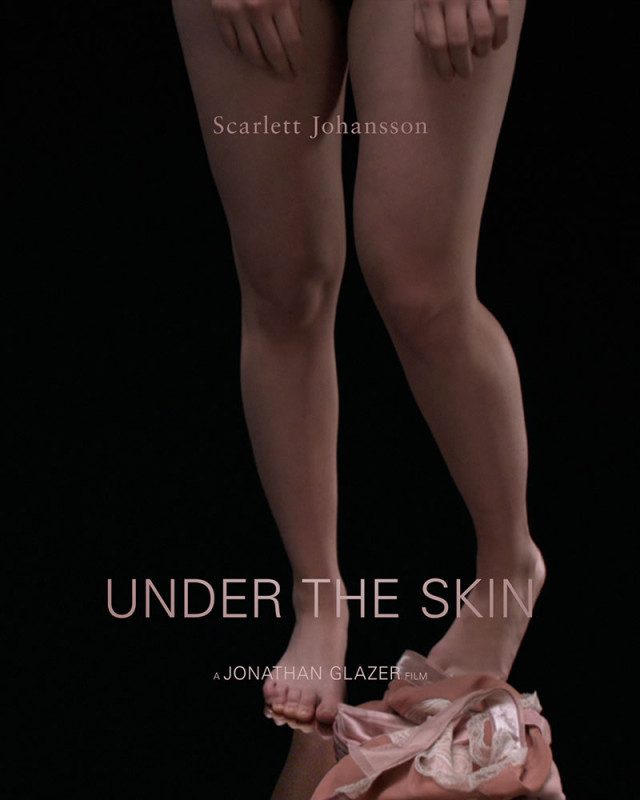
Scarlett Johansson roams Scotland as an alien in human form in British director Jonathan Glazer’s 2014 film, Under the Skin, a loose adaptation of Michel Faber’s 2000 book by the same name. Her unnamed character, all red pout, dark bob, and 100-mile stare, picks up unsuspecting young men in her white van and disappears them.
Worst hook-ups, ever.
From the opening scenes where we get the unsettling feeling that something bodysnatcher-esque is going on (what else to make of Scar-Jo, in a white-out stage, undressing herself as a separate person?) this is a slick and eerie piece of filmmaking. Glazer (Sexy Beast; Birth) cherry-picks Faber’s plot points and comes up with an elegantly atmospheric study of a stranger in a strange land—a stranger with a very gruesome pastime.
Part misandry-based revenge fantasy, part science fiction mash-up, Under the Skin weasels its way into your reptilian brain from its first baffling frames. You are meant to disregard nothing. Glazer completely ignores the brutally graphic and explanatory scenes at the heart of the novel.
In its artfully minimalist way, the film convinces us to side with the protagonist in her quest (I found myself mentally beckoning the more reluctant lads into the van), even as we remain in the dark about what she’s up to, right up to until the end. In one scene, the alien walks on a deserted, rocky beach, and encounters a man in wetsuit. Not far off, there is a couple with their baby and dog. Over the sound of the violent surf, we witness a terrible tragedy unfold: when the dog dives into the waves and gets carried out to sea, the woman follows, trying to save it, only to have the man swim out (in what must be bone-chilling water, even in summer) to save her.
Cruel minutes pass. The dog disappears. The man fails to reach the woman. As he flounders, the man in the wetsuit dives in to save the husband, at least, and he almost succeeds, except that the husband fights him off, because being saved would mean letting his wife drown for sure.
The three unfortunates perish in the waves. The man in the wetsuit lies on shore, exhausted. The newly orphaned baby sits crying his eyes out on the rocks. Oblivious to this tableau of agony, the alien takes a rock to the would-be hero and knocks him cold before laboriously dragging him up to her van.
Several conquests later, she picks up a man with a facial deformity, acts kindly toward him, and treats him to the same fate—until she sees herself in a mirror.  (This reminded me of the Tony Curtis movie about the Boston Strangler, where he catches his own reflection as he reaches for his victim; he spares her.) We later see the deformed man walking in a field stark naked and confused: freed, for some reason.
(This reminded me of the Tony Curtis movie about the Boston Strangler, where he catches his own reflection as he reaches for his victim; he spares her.) We later see the deformed man walking in a field stark naked and confused: freed, for some reason.
Does she want out of this interplanetary assignment? Is this man the catalyst she needs? Is she becoming human in some way? If so, the rest of the film shows her getaway.
Her attempts to inhabit her new body, to be more human, biologically speaking, are intriguing. She gags when she tries to eat, and freaks out when she realizes what really lies between her legs (and what, evidently, it can be used for). These scenes compel because they involve a persona otherwise depicted as fearless, unflappable. Glazer, however, nearly veers into inconsistency.
In his book, Faber has the wisdom to create a fully formed character, complete with a name and feelings, aims and doubts. There is no need for her to hijack anyone’s body. Before landing on Earth, Isserley, as she is called, was surgically altered to resemble a buxom human female. (There is much made of the fact that alien surgeons copied the pneumatic breasts they found in a magazine, thinking they would help her blend in; almost every man she meets gawks at them.) The transformation also involved shaving her entire body. Her species is sleekly pelted and sinuous, like giant otters or cats.
This ironic disparity fully comes to light, midway through the book, when Isserley meets another member of her kind, Amlis Vess, the son of the extremely wealthy owner of the meat-processing enterprise she works for. Vess is covered with soft fur, and we are to understand that he is gorgeous, smart, and wise.
Isserley hates herself for being strongly attracted to him, because she resents his wealth and out-of-place sentimentality. Their conversation pertaining to the “vodsels” (Homo sapiens) they capture, fatten, then consume as meat, could have been copped from a vegetarian manifesto.
“That meat you’re eating,” he said softly, “is the body of a creature that lived and breathed just like you or me.”
And later:
“No one told me they had a language,” marvelled Amlis … “My father always describes them as vegetables on legs.”
Isserley dismisses his opinions as pure sentimentality, the kind the elite are prone to spout, since they know nothing of “the real world.” Faber, deliberately or not, echoes the kind of exchange vegetarians or animal welfare advocates get into with mainstream omnivores—the loud majority, as it were—particularly farmers, who tend to lump all city folks together into one big group homogeneously unaware that nature is red in tooth and claw. (So easy, isn’t it, no matter who you are or what you stand for, to stop an argument cold by denouncing your opponent as naive or totally deluded?)
The two aliens in Faber’s book represent both sides of the meat-eating argument, making the novel’s core a kind of dialectic about where food comes from and how sentient creatures have to be before we are no longer willing to eat them.
How Glazer’s alien lures, then offs, her victims is staged beautifully, the minimalism pitch perfect. The killing zone is a slick, black jelly that the hopeful, concupiscent men sink into, without fear of any kind (perhaps focussing on Scarlett’s ass will do that to a guy). It’s a masterfully imaginative refiguring of Faber’s processing plant scenes, which are far from slick or beautiful, and are hard to read. They are not meant to  disorient, as Glazer’s are, but to reorient, to point us in a very specific direction, namely, consideration of the possibility that the animals we raise for the plate are every bit as feeling as we are.
disorient, as Glazer’s are, but to reorient, to point us in a very specific direction, namely, consideration of the possibility that the animals we raise for the plate are every bit as feeling as we are.
“We are all the same under the skin.” This is no longer the subversive statement it once was, but it remains a powerful challenge to the status quo. Farm animals, in the US alone, outnumber citizens 10 to one, and live as if they are not fully alive.
The two auteurs have very different agendas. Faber, in this and other novels, e.g., The Crimson Petal and the White (2004) and last year’s The Book of Strange New Things, uniquely combines sharp-eyed, attenuated compassion with an almost prurient fascination with bodily functions and misery. It’s as if he must rub his own face (and, by extension, the reader’s) in a harsh reality before he feels he has made his point: there is too much ugliness and suffering in the world, and we should obliterate as much as we can.
Faber dares us to turn away. Glazer, on the other hand, has no such intention. He is content to dangle what animal behaviorists call “sign stimuli” in front of us—Sexy Actress; Serial Killing; Backlash to Male Supremacy; Barren, Cold Landscape—and watch us react, like the good little lab animals we are.
I still think there is another film, more faithful and daring, to be made of Faber’s book. It would show the whys and the hows of the alien’s mission—complete with action-stopping scenes between the protagonist and her handsome foil arguing about food animals, sentience, our responsibility to those we deem inferior, and a whole lot more. Out would go the smirk-inducing sexuality that carries this film. It’s just a distraction. The real story is not the scary duplicity of an alien posing as a desirable human, right under our noses. It’s the true “under the skin” part. The part that forces us to think. But maybe that kind of horror is a little too close to home, and even a talented director like Glazer isn’t ready to dish it out just yet.
***
Image credits: Feature photo, photo 1, photo 2.




